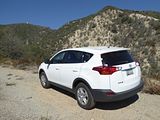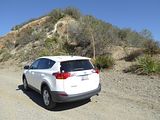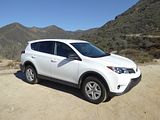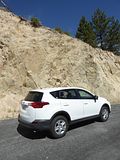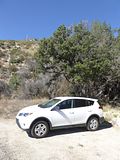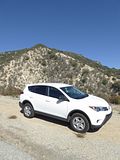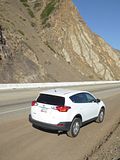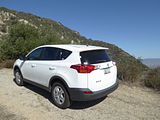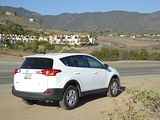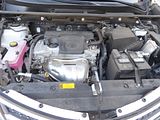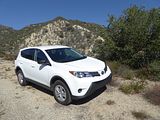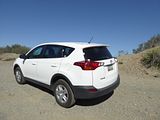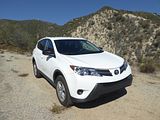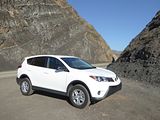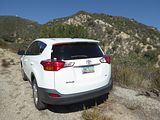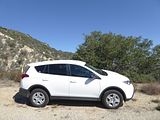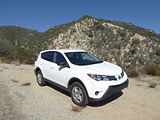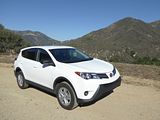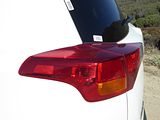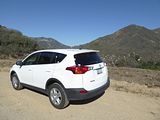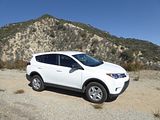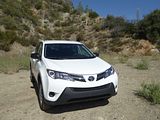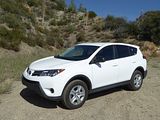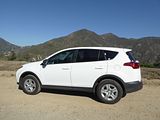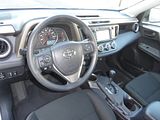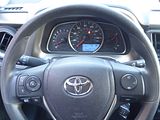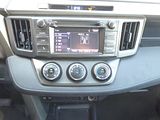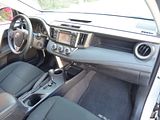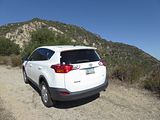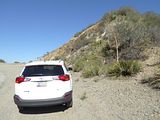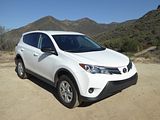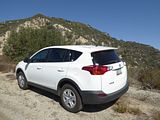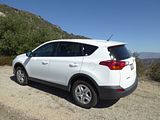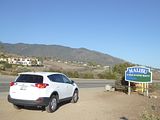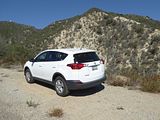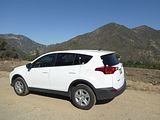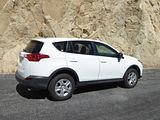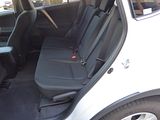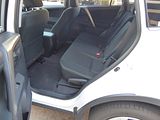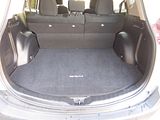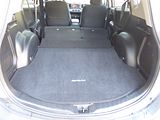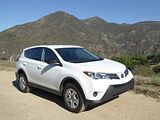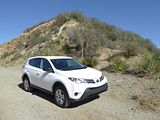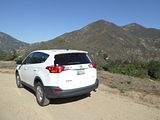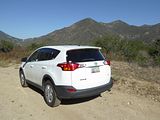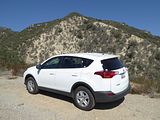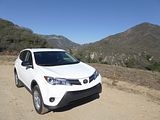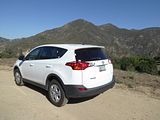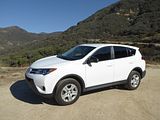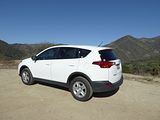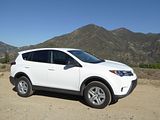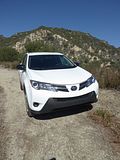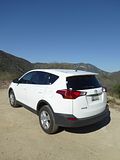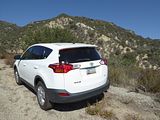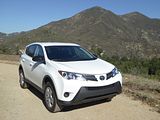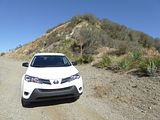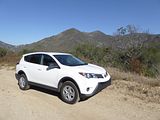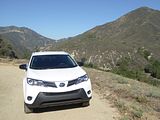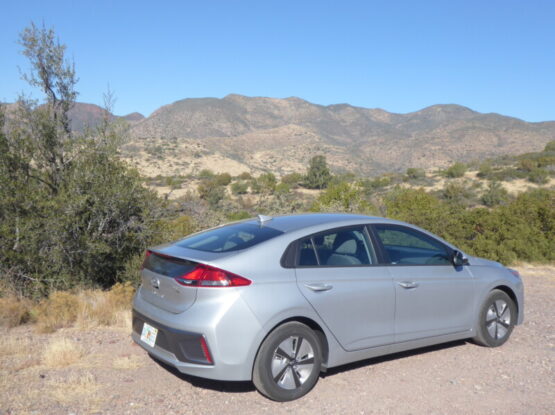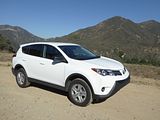

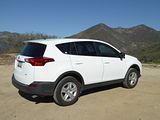
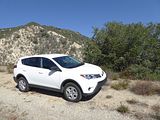
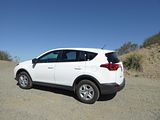
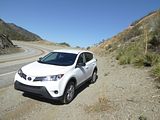
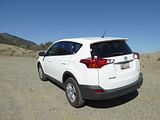

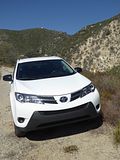
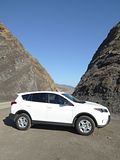
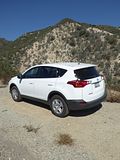
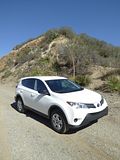
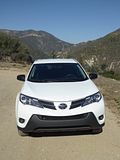
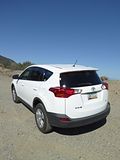
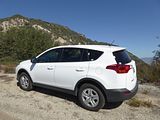
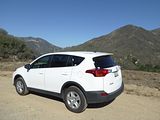
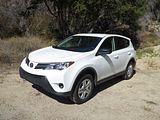
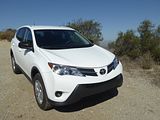
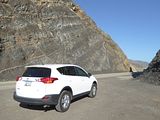

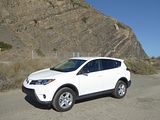
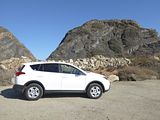
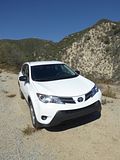
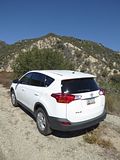
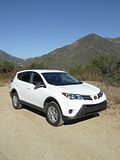
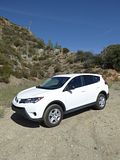
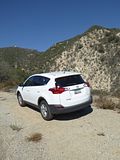
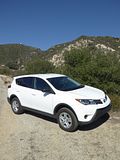


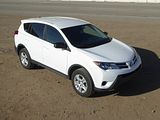
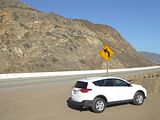
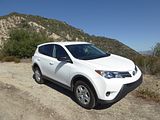
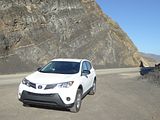

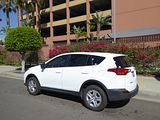

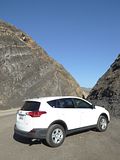
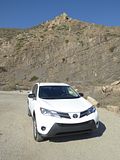
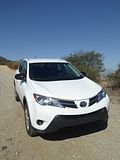
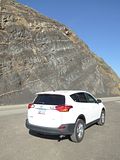
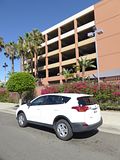
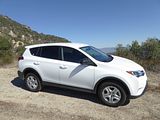
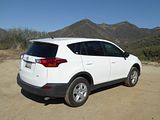
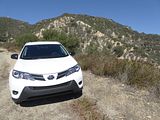
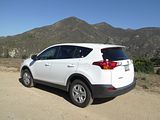
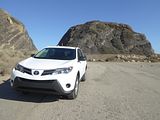
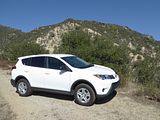
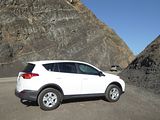
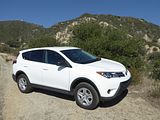


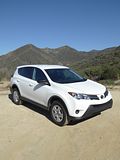
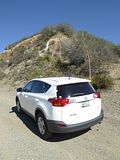
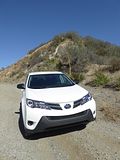
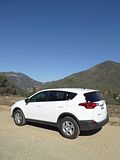
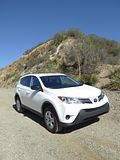
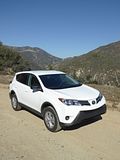
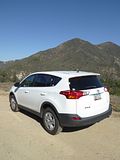
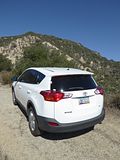
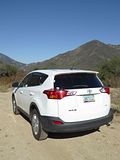
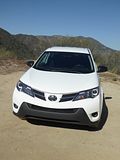
Third generation RAV4s were available with an optional 3.5 litre V6 engine which made them quite rapid, but that option was not carried over for the latest car, which comes as a four cylinder model only. In Europe, there is a choice of petrol or diesel, but US customers get no such choice. There is a 2.5 litre 4 cylinder petrol engine that puts out 176 bhp in every RAV4, and all of them have a 6 speed automatic gearbox. The only choice is whether to have front wheel drive or all wheels driven. Like an increasing number of rental Small SUVs, my test car was the former, which means that it is spared a bit of weight. That’s just as well, as the engine really does not feel powerful enough for the RAV4 the moment you show it any form of incline. I took the test car on the same roads as I had driven in one of its competitors, the Hyundai Tucson, a few days earlier, so it was easy to make a direct comparison. The Hyundai has about 4 bhp more, but out on the road, you would swear that the difference was greater than this. The Toyota had to work far harder coping with the only moderately steep gradients of the Little Tujunga Canyon, a road which had seemed far less of a challenge to the Hyundai. The first issue with asking the RAV4 to work harder was that it got a lot noisier. Whilst pottering around town, the engine seems decently smooth and refined, once it has to work harder, it loses the refinement and low noise levels. There is a conventional 6 speed automatic as opposed to the infernal CVT that had blighted the Corolla S earlier in the trip, but this gearbox was not the best, either. It was clearly programmed to try to hang onto a high gear as long as possible, so you had to be quite insistent with your right foot to persuade it to change down, and then it did not want to change up again when it could. There is a manual mode on the gearlever, when in S model as opposed to D, though there are no column paddles. There are three modes for the RAV4 available: Normal, Eco and Sport. These modes supposedly change the throttle response and transmission behaviour. I did not notice much difference. The next consequence of this came as I watched the fuel needle move down steadily and surprisingly rapidly. I don’t think the RAV4’s tank was particularly full when I collected it, but the needle made fast and constant progress downwards,
Another respect where the RAV 4 does not entirely conform to the Toyota tradition is with its steering, but that’s a good thing Although the plastic steering wheel of the test car was not particularly nice to hold, at least the steering system for which it was the interface was less vague than you will find in most of the Toyota models. It is in no way going to trouble the likes of Ford or Mazda with the feel and precision that it imparts, but it is at least not overly assisted and you have some idea of where the front wheels are headed as a result of turns you make on the wheel. The handling won’t win prizes, either, but equally, it should avoid the worst of the brickbats. Press on somewhat and you will find clear understeer, but you can tackle some of the more swooping bends with a certain amount of gusto without feeling unduly worried. The suspension is predictably soft, and that means that the RAV4, with a far longer wheelbase than you found on those early cars, rides over the varied surfaces of SoCal’s roads with reasonable comfort. There were no issues with the brakes, which had a nice progressive feel to the pedal. A conventional pull up handbrake is fitted between the seats. Visibility is not a problem, either. There is a good field of view from the door mirrors, and thanks to a rear view camera which features even on the lowly LE model, you get a clear view of what is behind when you are reversing.
There is a clear family resemblance to other Toyota models like the current Auris inside the RAV4, too. Toyota have presumably tried to come up with a design that avoids the impression of having a huge slab of plastic in front of the driver and passenger. They have only been partially successful. The materials they have chosen are hard, and feel cheap to the touch, and like almost every Toyota I ever come across, this one had a vast number of scratches in the plastic all around the ignition key slot, something you never really see in other brands. The main dash moulding was black, with some gunmetal grey inlays used to try to provide some visual relief, but they did not really lift it much, and nor did the bizarre faux carbon-fibre like inlays around the gearlever and the door armrests, which just looked plain odd. There is one large central dial in the pod in front of the driver, for the speedometer, with smaller units on either side for rev counter and fuel level to the right. Water temperature is shown as a small digital bar chart, in the area that is used for the odometer and other trip information that you cycle through by pressing a button on the right hand spoke of the steering wheel. The gauges are clearly marked and easy to read. Centre of the dash contains the small 6.1″ touch sensitive colour screen for the Entune audio and infotainment system. There are only three buttons on either side of the unit and an on/off and tuning knob above it, so it looks simple and indeed it is simple. The same colour bar chart showing fuel consumption over the past 15 minutes as I found in the Camry and Corolla models I drove earlier in this trip features, as do options for AM and FM radio, Bluetooth and phone connectivity, voice recognition and some set up screens. The angle of the display screen was such that it caught the late afternoon sun as I was driving along the coast and almost blinded me with the reflection and glare coming off it, something I have never experienced in any other car. Below this unit are three rotary dials for the air conditioning system. It was hot whilst I had the RAV4, and to get any form of a flow of air into the cabin, I had to have the fan on at least the third of four speeds, which made it noisy. Twin column stalks are used for the lights and indicators on the left and wipers on the right of the wheel. There are audio unit repeaters on the steering wheel boss, whilst the cruise control works from a stubby stalk set low on the right of the wheel. Two small switches for Eco Mode and Sport Mode are set down very low in the central part of the dash which is somewhat further back than the higher areas of the moulding.
Seat adjustment is all manual, with a bar under the seat and two release levers on the seat side for height and backrest rake. The seats were covered in a black cloth with a pattern which was barely distinguishable from the rest of the covering, once again showing no visual flair at all. The wheel adjusted up and down as well as in and out, so I was at least able to get comfortable.
Rear seat passengers will be better off here than in the Tucson, as one advantage of the Toyota’s extra size is that there is more room in it. With the front seats set well back, there is still a reasonable amount of leg room. The backrest angle can be varied using the same lever as is used to fold the seat down. There’s not much of a central transmission tunnel, and the extra height compared to a regular saloon means that occupants here will appreciate the Crossover-ness of the RAV4. They do also get a central armrest, which has a pair of cup holders in its uppermost surface. The middle seat belt is mounted on the roof, with all the challenges that this brings, especially when you fold the rear seats down. You may need to do that if you have lots of luggage, though with the rear seats erect, the boot is a reasonable size. You don’t get a load cover in the LE model, which always seems mean, but is normal practice on US market cars, it would seem. Gone is the side hinged tailgate of previous models, and the spare wheel is mounted under the boot floor rather than on the tailgate, which makes it a lot easier to get in the boot in confined spaces than was the case with the older models. The tailgate itself did not seem to lift as high as you might expect, though I understand you can change this in models with electrical assistance. The boot is a good size, among the biggest in the class, according to the quote figures. You can get mode space as the rear seat backrests simply drop down onto the cushions, giving a flat load area. Inside the cabin, there is a good sized glovebox, an open shelf area above this in the dashboard, and there are some odd shaped cubby areas in front of the gearlever, along with twin cupholders and a deeper cubby under the central armrest. The door bins are very modest in size, but they do feature on all four doors, and rear seat passengers get pockets on the back of both front seats.
There are three different version of the US market RAV4: LE, XLE and Limited. The cheapest of them, an LE with front wheel drive was listed at $23,600 for 2015, making it a couple of thousand dollars more expensive than the Tucson. It is modestly equipped, with 17″ wheels covered by plastic wheel trims, and blanking plates where fog lights go on the more costly models, but you do get the rear-view camera, auto-off headlights, an acoustic noise-reducing windscreen, an alarm and anti-theft system, cruise control, the Entune system with 6.1″ touch sensitive colour screen, AM/FM radio, voice recognition, MP3, AUX, Bluetooth and wheel mounted controls. The one-touch operation for the driver’s window only applies when you are opening it. To close, you need to hold the switch all the time, which was irritating. All wheel drive adds $1500 to the price. The XLE, listed at $25,240 for a front wheel drive model, adds 17″ alloy wheels, a silver highlighted lower grille, an electric tilt/slide glass sun roof: roof rails, dual zone automated climate control, heated mirrors with integrated indicator repeaters, an Auto up on the driver’s electric window, 8 way adjustable front driver’s seat, a rear load cover, and an upgraded Entune Audio Plus unit with XM Satellite radio and HD radio, and when navigation is fitted, the smartphone app controlled functions such as Bing. Upgrade to a $28,450 Touring and you get 18″ alloys and stiffer suspension, an 8-way power adjustable driver’s seat with memory and seat heating, a mirror memory, a power operated tailgate with remote release, a leather wrapped steering wheel and gear lever knob, auto dimming rear view mirror and Sof-Tex leatherette seat covering and Entune Premium Audio with Navigation and App Suite.
The RAV4 met my expectations. That is not, however, a particular compliment, as I was not expecting to be overly impressed by it. And I was not. Like most Toyota models, there’s nothing much that is actively bad about it, it is just that there are plenty of rivals that are that bit better in some or all regards. You get the feeling that Toyota are trading on former glories and relying on the loyalty of their vast customer base rather than trying hard to produce something that could genuinely achieve conquest sales. Whilst not actively ugly, this RAV4 will win no prizes for its looks, its engine feels outclassed, it is not as economical as it should be, it is dull to drive, the interior is made of cheap feeling materials and there is no design flair to speak of. Toyota should worry, as arch-rival Honda’s CR-V is now the world’s best-selling SUV model, and it frequently outperforms the Toyota in the critical US market. I’ve not driven one, so cannot comment on its dynamic prowess, and whilst it is also far from a thing of beauty and elegance, there are clearly plenty of people who think it has something to offer that the Toyota lacks. There is no shortage of other competition. As well as the Hyundai that I drove a few days earlier to this test, and which on the whole I thought was a better product even in its recently superceded guise, there is a new Kia Sportage waiting in the wings, as is a second generation VW Tiguan, and already available and selling far better than ever is the Nissan Rogue and there are the good to drive Ford Escape and Mazda CX5. Even the small Jeeps are valid competitors these days, and there is also the highly rated (in America) Subaru Forester. Rental car companies would disagree, as they class them a size higher, but GM compete here too with the Chevrolet Equinox and GMC Terrain. Based on my experience, I would pick absolutely any of these over the Toyota if I had a free choice. Just as I would pick anything over a Corolla or a Camry. One day, perhaps, the sales stats will catch up with the reality that Toyota really are the masters of producing dull vehicles, and you can do much better almost anywhere else.



